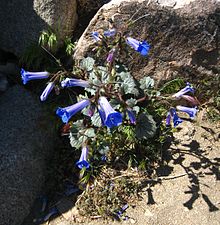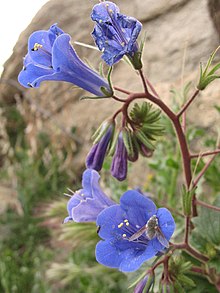Bell phacelia
| Bell phacelia | ||||||||||||
|---|---|---|---|---|---|---|---|---|---|---|---|---|

Bell Phazelie ( Phacelia campanularia ) |
||||||||||||
| Systematics | ||||||||||||
|
||||||||||||
| Scientific name | ||||||||||||
| Phacelia campanularia | ||||||||||||
| A.Gray |
The bell phacelia ( Phacelia campanularia ) is a species of the genus Phacelia within the family of the predatory leaf family (Boraginaceae). Some more common names are: Bellflower- Tufted Beauty , Bell-Phacelia, Bell- Tufted Beauty , Desert- Blue-Bell , Bee Friend or, in English, Desertbells. This endemic occurs only in southern California , in the Mojave and Sonora deserts . It is used as an ornamental plant almost worldwide.
description
Vegetative characteristics
Phacelia campanularia grows as an annual herbaceous plant and reaches heights of up to 0.7 meters. The above-ground parts of the plant are hairy glandular. The independently upright stem can be branched from the base and is covered with short glandular hairs.
The alternate arranged on the stem leaves are divided into petiole and leaf blade. The simple leaf blade is ovate to ± circular with a serrated leaf margin.
Generative characteristics
The flowering period in California extends from February to May. The flowers are in the zymous inflorescence are relatively close together. The flower stalk is 7 to 30 millimeters long.
The hermaphrodite flower is radially symmetrical and five-fold with a double flower envelope . The five identical, durable, short glandular hairy sepals are fused at their base; they elongate until the fruit is ripe and are then elongated with a length of 5 to 10 millimeters. The five petals are fused. The corolla tube is twice as long as the corolla lobes. The bright blue corolla is up to 4 centimeters long and bell-shaped, wheel-shaped or funnel-shaped, depending on the variety. The corolla lobes are rounded. The corolla can have white spots in the throat. The five fertile, identical stamens protrude over the corolla with a length of 20 to 45 millimeters. The hairy, blue stamens have bald wings. The ovary is unicameral. The two 20 to 45 millimeter long stylus branches are fused from their base to at least 1/4 or at most 1/2 of their length.
The capsule fruit with short glandular hairs is egg-shaped with a length of 7 to 15 millimeters and contains 40 to 90 seeds. The approximately 1.5 millimeter long seed has a net-like, brown seed coat .
Chromosome set
The basic chromosome number is x = 11. In the subspecies Phacelia campanularia subsp. vasiformis there is diploidy with a chromosome number of 2n = 22.
Systematics and distribution

The first description of phacelia campanularia was made in 1878 by Asa Gray in synoptical Flora of North America. New York , Volume 2, Issue 1, page 164.
The type phacelia campanularia belongs to subsection Campanulariae G.W.Gillett from the section Whitlavia (Harv.) Benth. & Hook. f. in the subgenus Phacelia within the genus Phacelia Juss.
From phacelia campanularia there are two varieties, had the rank of subspecies before 2012:
- Phacelia campanularia A.Gray var. Campanularia (Syn .: Phacelia campanularia A.Gray subsp. Campanularia , Phacelia minor var. Campanularia (A.Gray) Jeps. ): This endemic thrives at altitudes below 1600 meters only in the western Sonoran Desert .
- Phacelia campanularia var. Vasiformis (GW Gillett) Walden & R. Patt. (Syn .: phacelia campanularia subsp. Vasiformis G.W.Gillett ): It comes in California at altitudes less than 1,600 meters in the Mojave Desert and the northern Sonoran Desert before.
ingredients
The anthocyanin pigment phacelianin was isolated from the flowers of Phacelia campanularia and is involved in the formation of their blue color. Phacelianin is also responsible for the blue flower color of Evolvulus pilosus .
Skin irritation ( contact dermatitis ) can occur if the parts of the plant are touched .
Individual evidence
- ↑ a b c Phacelia campanularia in the Germplasm Resources Information Network (GRIN), USDA , ARS , National Genetic Resources Program. National Germplasm Resources Laboratory, Beltsville, Maryland. Retrieved June 18, 2019.
- ↑ Photos at the Bochumer Botanischer Verein e. V.
- ↑ a b c d e f g h i j k l m n o p Genevieve K. Walden, Robert Patterson, Laura M. Garrison, Debra R. Hansen 2013: Phacelia : Datasheet in Jepson Flora Project (eds.) Jepson eFlora , Revision 1.
- ^ A b Asa Gray : Synoptical Flora of North America. New York , Volume 2, Issue 1, 1878, p. 164. scanned at biodiversitylibrary.org .
- ↑ Phacelia campanularia at Tropicos.org. In: IPCN Chromosome Reports . Missouri Botanical Garden, St. Louis
- ↑ Phacelia campanularia at Tropicos.org. Missouri Botanical Garden, St. Louis, Retrieved June 18, 2019.
- ^ A b Genevieve K. Walden, Robert Patterson: Nomenclature of subdivisions in Phacelia (Boraginaceae). In: Madroño , Volume 59, 2012, pp. 211–222. doi : 10.2307 / 41702547 - subsection Campanulariae on p. 217.
- ^ DR Hansen, Greg S. Spices, Robert Patterson: Phylogenetic relationships between and within Phacelia sections Whitlavia and Gymnobythus (Boraginaceae). In: Systematic Botany , Volume 34, 2009, pp. 737-746.
- ↑ Structure of anthocyanin from the blue petals of phacelia campanularia and its blue flower color development. at US National Library of Medicine National Institutes of Health .
Web links
- Vascular Plants of the Americas : Phacelia campanularia at Tropicos.org. In: 83 . Missouri Botanical Garden, St. Louis
- Datasheet at the Lady Bird Johnson Wildflower Center at the University of Texas at Austin.
- Datasheet at Calscape.
further reading
- Cynthia Gilbert, John Dempcy, Constance Ganong, Robert Patterson, Greg S. Spicer: Phylogenetic Relationships within Phacelia Subgenus Phacelia (Hydrophyllaceae) Inferred from Nuclear rDNA ITS Sequence Data. In: Systematic Botany , Volume 30, Issue 3, 2005, pp. 627-634. JSTOR 25064090 PDF.
- Reynolds et al .: Contact Dermatitis , Volume 14, 1986, pp. 39-44.
- Reynolds, Rodriguez: Phytochemistry , Volume 18, 1979, pp. 1567-1568.
- Reynolds, Rodriguez: Phytochemistry , Volume 20, 1981, pp. 1365-1366.
- Reynolds, Rodriguez: Planta Medica , Volume 43, 1981, pp. 187-193.
- Reynolds, Rodriguez: Phytochemistry , Volume 25, 1986, pp. 1617-1619.


